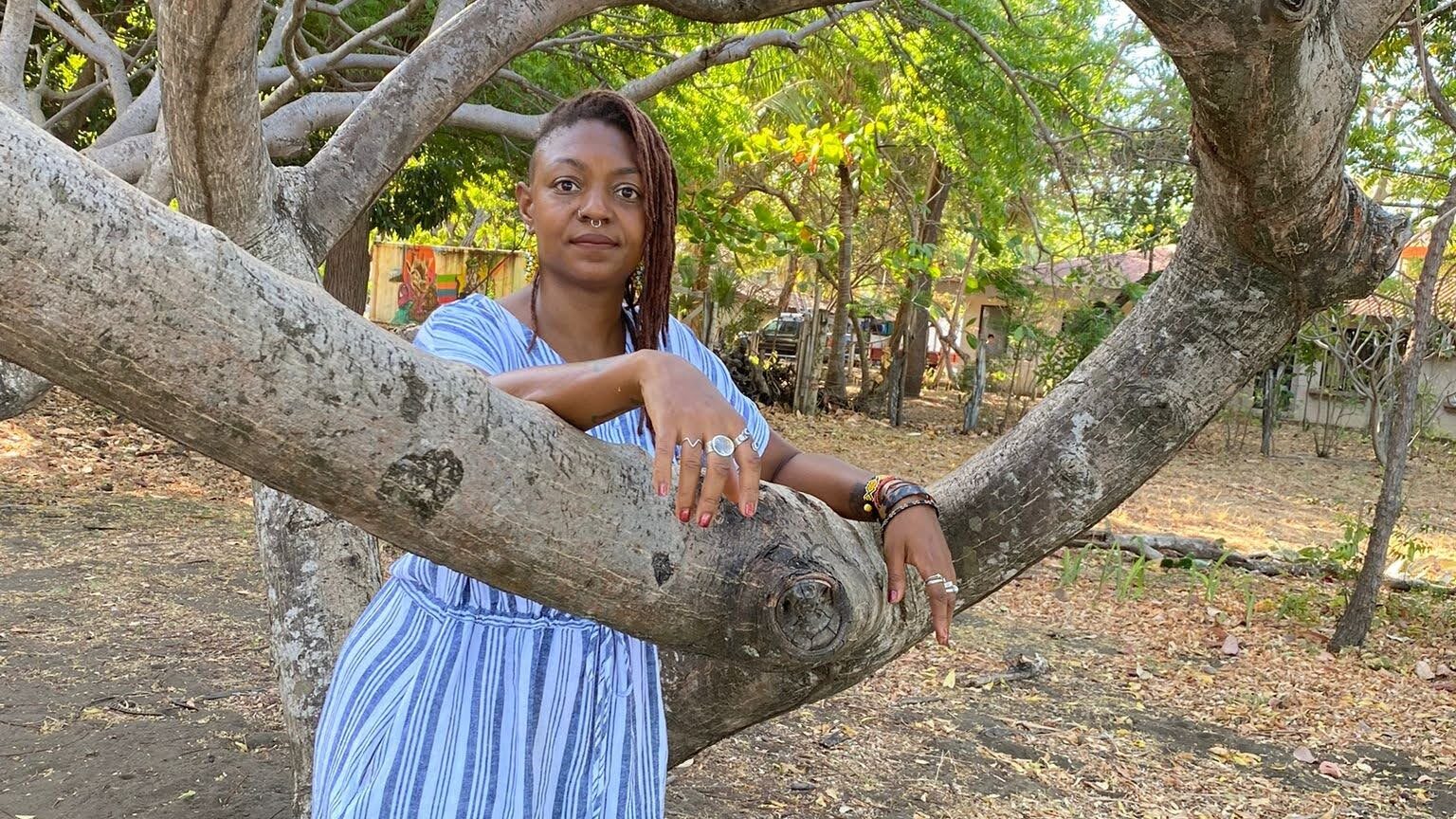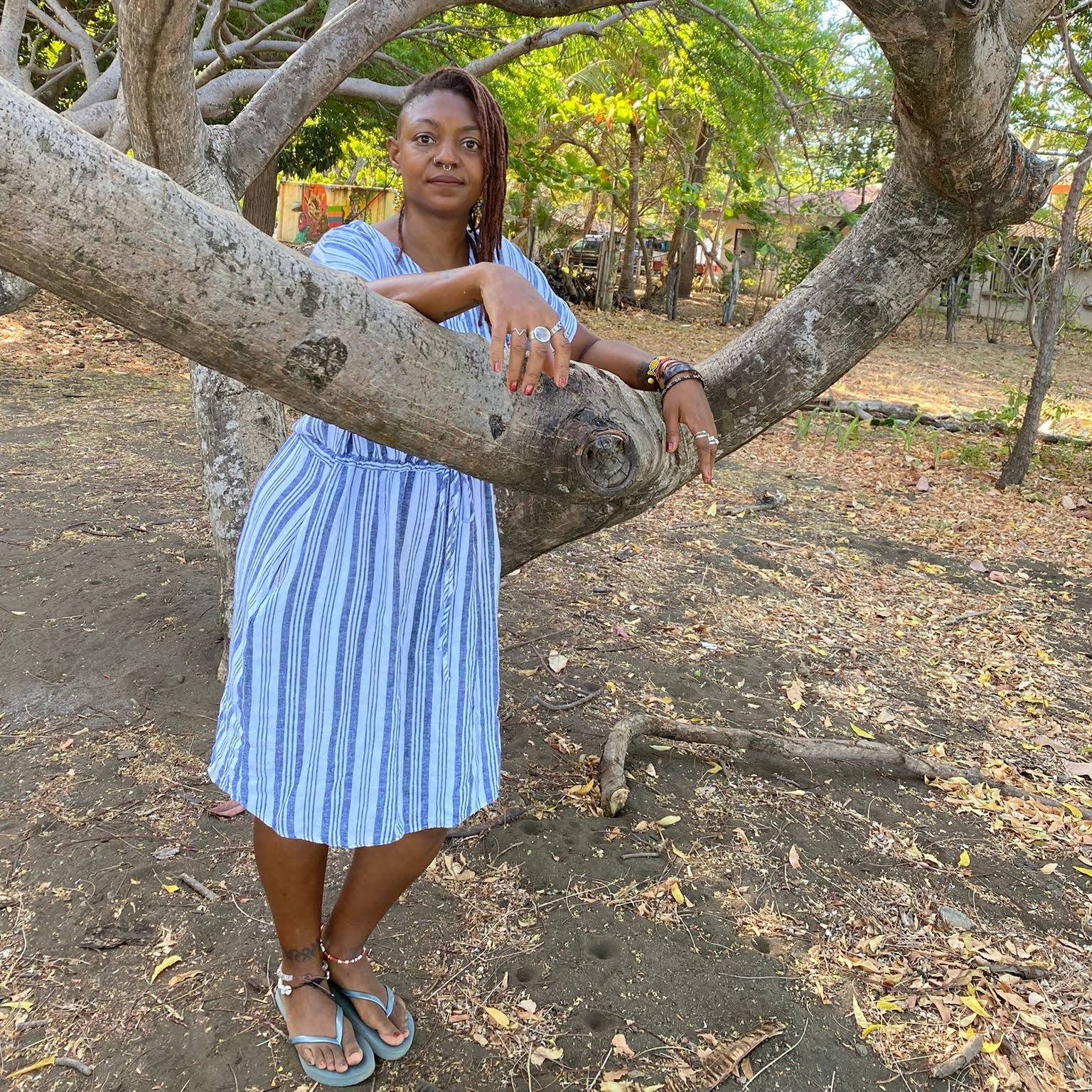The multidimensional writer shares her journey of self-discovery and holistic health.

Raychelle Heath is a true polymath: she’s a writer and a poet; a podcaster and visual artist; a translator and a teacher; and a yogi and meditation instructor. When she is not writing, you can find her engaging with the wellness community as a certified Kripalu Yoga, Yoga Nidra, and Mind-Body Meditation instructor. Heath claims the world as her own — spending time traveling and planting memories in multiple countries, always remaining in touch with her roots. From her home in Costa Rica, she promotes safe spaces for expression and self-discovery and uses her voice to tell the stories of Black women in the world of wellness, exploring issues of health, art, and self-care in her podcast “Black Women in Wellness.” When we spoke over Zoom last winter, Heath told Sampsonia Way about her experiences with the power of community and language and shared the importance of mental health and wellness for holistic health.
To learn more about her writing and her teaching, visit her website. To read her poetry in the “Everyday Pandemic” series, visit here.
The Power of Community and Spoken Word
I’m intrigued by the title of your chapbook Between Tea Leaves and Tree Leaves. Could you tell me a little about that?
Between Tea Leaves and Tree Leaves was this fun moment for me. At that time I was doing a lot of arts outreach and community work. I met Margaret Drummond who ran a small press called Thrift Poetic Arts. She helped me birth that chapbook, and it was a labor of love. But what was so beautiful about the project to me was that it showed me the power of a small press and its community. With the initial sales of the book, I paid it forward and helped someone else publish their poetry manuscript. We had a contest and received manuscripts from a variety of people. It was really great to be able to build community through publication.
How has spoken word shaped you as an artist and a writer?
The world of spoken word is incredibly important to who I am as a writer, as a person, and understanding art spaces, spaces to build community, and how to create a safe space for expression. I think that seeing how your writing lives off of the page is important. It gets you out of your head. And it really lets you understand that, while this is an important expression of who you are, it’s not self-contained. You’re giving it to someone. And the most immediate way to see what that exchange looks like is to perform.
I saw that you were a part of the “My South Speaks” spoken word campaign in the Carolinas. As one of the writers there, you were among the audience when you were not performing. Was there anything that somebody said in one of their performances that you felt on a deeper and emotional scale?
That was orchestrated by some poets in the community who knew about the campaign, and they wanted it to come to the Carolinas. I think what was most memorable to me about that moment was to hear people of color talk about their experience in the South. To hear people talk about it being their place of origin: that Black people do exist and we’re not all running from racist white people. The South has this really conflicted space of great beauty but also great darkness — and growing up in that space forms you in a particular way. And I feel very grateful for that. I remember a feeling of connectedness and understanding: that we are very much thriving and that this is a space where people can continue to grow and thrive.
Black Women in Wellness and Mental Health
You have a podcast, Black Women in Wellness, and there I discovered your piece I Fell for Self-Healing. You mentioned having some anxiety attacks and that you saw a few specialists who said you needed medication if you wanted to get better. But instead, you started coping differently with yoga, spirituality, clean eating, writing, and expressing yourself. But it still came down to you needing the medication. I’m interested in knowing a little more about why you originally didn’t lean towards it?
I think it had more to do with me not wanting to be dependent on something. When the medication was first presented to me, it was “You can either take this for the rest of your life, or you can quit your job.” I think when presented with that ultimatum, I thought, “I’m not doing either of those things.” I was young and healthy and didn’t understand why my body and mind were betraying me. And I think a lot of conversations in the wellness community kind of put the blame on the person when something is going wrong, when there are really medical issues that are beyond your control. It’s very frustrating to me to see this rhetoric from so many wellness providers — that if you just eat clean and do these woowoo things, you will magically be healthy. Sometimes you also have to have medical interventions. When I saw a doctor for the second time, it was a very different conversation. It was, “We are in a global pandemic; you are experiencing symptoms of anxiety; here is a medication that will help you; take it as needed. If it doesn’t work, come back.” I didn’t feel like my autonomy was being taken away. It was a totally different experience.
In addition to the rhetoric from wellness providers, do you think the stigma around mental health in the Black community also plays a role in not getting mental wellness help?
I think there is a great stigma around wellness for Black folks. I also think that we’re very invisible in wellness conversations, which is why I started Black Women in Wellness. We’ll go to the doctor for blood pressure; we’ll go to the doctor for high cholesterol; everybody knows about sugar and diabetes. But to go to a medical professional to deal with your mental health is often seen as a sign of weakness. You either go to church or talk to a family member. My family members are amazing, but they’re not medical professionals that can deal with mental health. And so, really removing that stigma around taking care of our holistic health — which is mental, spiritual, and physical — is important. The more of us who are going to therapy and who are taking medication in order to support our mental health, the more vocal and visible we are, the less stigma there is for other Black folks. That’s part of the reason why I wrote that piece: to say stop feeling like you are that self-contained. Yeah, it’s okay if you can’t fix yourself. It’s okay to get a medical professional to help you with that.
What have you done for yourself that has improved your anxiety?
I often say that the best thing I did for my anxiety was to leave the U.S. I moved to a remote island in the Pacific, the Marshall Islands, where there are almost no guns and it’s a small community. That’s not to say there isn’t violence or corruption, that happens everywhere. I wouldn’t sugarcoat the experience either. I dealt with a lot of things that I had not dealt with before — like water shortages, not having an internet connection to be able to connect with my loved ones, and other issues. And I was often the only Black person or the only Black woman in the room so it can get to a point where I’m not surrounded by people who I share that connection with. Despite that, I didn’t have the anxiety of worrying about somebody hurting me because I’m a Black person or because I’m a woman. Taking that weight off of my shoulders did a world of good for my mental health.
I know you are a big believer in yoga and have done so much to pave your way in this community. Is this something that has helped you stay present in your everyday life?
Yes. I definitely think yoga, which I believe also includes meditation, has helped me ground myself. It is a very holistic practice for my wellness, but it is in symphony with all of the other things I do for my wellness.
When was the moment when you decided, okay, I’m going to teach other people how to do yoga?
Funnily enough, I didn’t get into yoga teaching until I went to the Marshall Islands. There was an amazing yoga teacher there, but she was planning to leave the island and asked me to take over her classes. I would get up early in the morning, go to her apartment, train, go to work at my teaching job, and then go home, grade papers, and read yoga books. Eventually she left, and I took over her classes. I’ve been teaching ever since she left in 2008. It was interesting at the beginning — but something sparked and I went on to get my 200 hour certification at Kripalu, and have since done more certifications for Yoga Nidra and Mind-Body meditation. All amazing experiences. As of recently, I’ve been teaching a lot more meditation than yoga, but they are both really important practices to me.
You mentioned that you’re teaching a lot more meditation than yoga nowadays and I saw that you were a meditation instructor for three years at the Move Forward Women’s Day conference. I’m guessing when you do these meditation guides, everybody in the room probably hasn’t meditated before. How do you get people comfortable enough to try something as powerful as that?
I think that a lot of what freaks people out about those practices is the lead in. There’s a lot of pressure to be still and empty the mind. I try to get people to tap into their breath and use that as an anchor. I also invite people to close their eyes if that feels safe. I think it’s important to create a safe space around meditation. And I had to learn that as I developed as a meditation instructor. When people feel safe, they’re able to lean into practices a little bit better. Especially with meditation. There are a lot of things that are coming up from the subconscious, so it’s important to set the stage that this is a safe practice and that you are in control of the practice. And also, to give participants permission not to participate if it doesn’t feel safe. When I first started guiding meditation, I had some participants tell me that their experience wasn’t the best. That helped me realize that I needed to put a few more parameters around the practice before having people enter into it. So, creating the foundation for safe space first and also giving people permission not to participate is really important. And I do this in my yoga classes as well. It goes a long way for people to be able to open up to the practice.

About the Series: This interview is part of our ongoing series exploring isolation, exile, and “The Everyday Pandemic.” Throughout this series it is our hope to capture the daily toll of life through the pandemic from the perspective of writers and artists who are familiar with the experience of isolation or exile. With this in mind we’ve collected stories, poems, nonfiction essays, and digital art from writers and artists from all walks of life and from all around the globe.
Daishon Spann is a staff writer for Sampsonia Way Magazine


